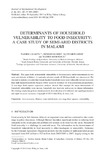| dc.contributor.author | Wambui, Kogi-Makau | |
| dc.contributor.author | Mkwambisi, David | |
| dc.contributor.author | Nyariki, Dickson | |
| dc.contributor.author | Kakota, Tasokwa | |
| dc.date.accessioned | 2014-07-24T06:12:04Z | |
| dc.date.available | 2014-07-24T06:12:04Z | |
| dc.date.issued | 2013 | |
| dc.identifier.citation | Kakota, Tasokwa, Dickson Nyariki, David Mkwambisi, and Wambui Kogi‐Makau. "DETERMINANTS OF HOUSEHOLD VULNERABILITY TO FOOD INSECURITY: A CASE STUDY OF SEMI‐ARID DISTRICTS IN MALAWI." Journal of International Development (2013). | en_US |
| dc.identifier.uri | http://onlinelibrary.wiley.com/doi/10.1002/jid.2958/full | |
| dc.identifier.uri | http://hdl.handle.net/11295/73283 | |
| dc.description.abstract | This paper looks at household vulnerability to food insecurity and its determinants in two semi-arid districts in Malawi. A randomly selected sample of 200 households was interviewed. The descriptive statistics revealed that female-headed households were more vulnerable to food insecurity than male-headed households because of low access to resources for food production and purchases. A two-stage least squares regression analysis showed that amongst the main determinants of household vulnerability were income, household size, land size and access to climate information. The findings imply that policies should promote diversification of livelihoods and equal opportunities and rights to access resources. | en_US |
| dc.language.iso | en | en_US |
| dc.title | Determinants Of Household Vulnerability To Food Insecurity: A Case Study Of Semi‐arid Districts In Malawi | en_US |
| dc.type | Article | en_US |
| dc.type.material | en | en_US |


